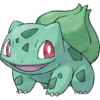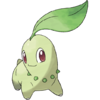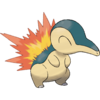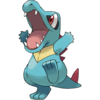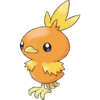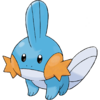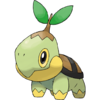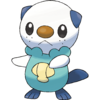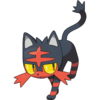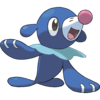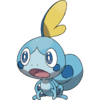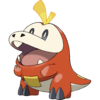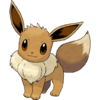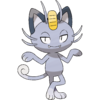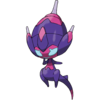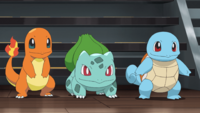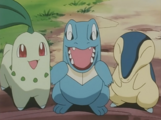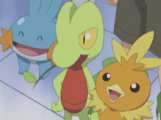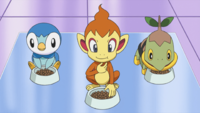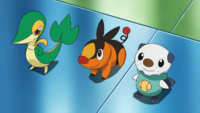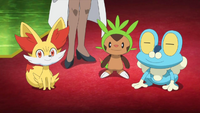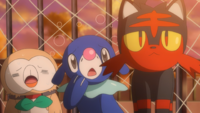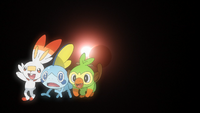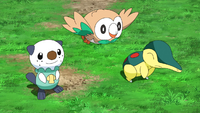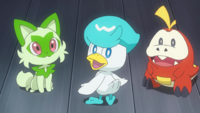First partner Pokémon: Difference between revisions
m (→Orre) |
|||
| Line 1: | Line 1: | ||
[[File: | [[File:Pokémon Day 2022 Kanto Artwork.png|thumb|300px|{{ga|Red}} picking his first partner Pokémon]] | ||
A '''first partner Pokémon''', also referred to informally as a '''starter Pokémon''', is the first {{OBP|Pokémon|species}} that a {{pkmn|Trainer}} owns at the start of their [[Pokémon journey]]. This primarily refers to {{t|Grass}}-, {{t|Fire}}-, or {{type|Water}} Pokémon given to players by a [[Pokémon Professor]] or other mentor at the beginning of the [[core series]] [[Pokémon games]], as well as {{p|Pikachu}} in {{game|Yellow}} and Pikachu or {{p|Eevee}} in {{LGPE}}. However, the term can sometimes be used to refer to any Pokémon that was the first one owned by a Trainer. | |||
In the games, the player's first partner will be used to battle the first [[wild Pokémon]] they encounter. Once another Pokémon is {{pkmn2|caught}}, their first partner may be retired, but it is often with this Pokémon that Trainers learn [[friendship]] and trust. As such, even advanced Trainers may still use their first partner Pokémon, and they will often be the most powerful Pokémon on their respective teams. | |||
It is said that the first partner Pokémon are extremely rare in the wild, accounting for their uniqueness in each game. | |||
In the creative process, first partner Pokémon are the Pokémon from each game that the most work goes into, and usually take significantly more time than other Pokémon in each [[generation]].<ref>[https://www.gamesradar.com/how-pokemon-are-born/ How Pokemon are born | GamesRadar+], by Michael Grimm, published 20 March 2009</ref> | |||
In | |||
==Terminology== | |||
[[File:First Partner Pokémon Abound.png|thumb|300px|Promotional image for [[The Indigo Disk]] using the term "first partner Pokémon"<ref>[https://scarletviolet.pokemon.com/en-gb/news/first_partner_pokemon/ Pokémon Scarlet and Pokémon Violet | Familiar First Partner Pokémon].</ref>]] | |||
{{main|Terminology of first partner Pokémon}} | |||
Since [[Generation VI]], "first partner Pokémon", sometimes shortened to "first partner", has become the primary term used to describe these Pokémon across official media. It is sometimes shortened to simply "first partner". Occasionally, other Pokémon have been referred to as first partner Pokémon, such as {{p|Poipole}} in {{pkmn|Ultra Sun and Ultra Moon|Pokémon Ultra Sun}} and various Pokémon in {{g|Masters EX}}. Krysta Yang, a former public relations manager at [[Nintendo of America]], has claimed that the phrase "partner Pokémon" is preferred in official communication due to "starter Pokémon" implying that the player will "be rid of them" later in the game.<ref>[https://www.youtube.com/watch?v=vqQEFEjLybE&t=6120s Nintendo's Big Announcement Season EXPLAINED - EP81 Kit & Krysta Podcast | Kit & Krysta on YouTube] — Krysta Yang: "They did start using 'partner Pokémon' a couple of years back, but it's been hard for them to get people to catch on to this official terminology because people like to say 'starter Pokémon.' ... I think there was something about how, if you call it a 'starter Pokémon,' you're basically saying that you will be rid of them. ...That was one of the reasons, I believe, is that if you call it a 'starter Pokémon,' it's like, oh, you're only just going to start the game with it, and then you ditch it for your, like, shinies and your legendaries. ... So then the 'partner Pokémon' became the phrasing that they liked better because it's like, 'this is your partner for your whole adventure,' like you really want to get attached to this character, this Pokémon that you start your game with, but it's not just who you start your game with..."</ref> | |||
Historically, these Pokémon were known as "starter Pokémon", or "starters", though these terms were rarely used in the {{pkmn|games}} and used occasionally during the second through fourth series of ''[[Pokémon the Series]]''. From ''[[Pokémon the Series: XY]]'' onward, "starter Pokémon" was no longer used in the {{pkmn|animated series}}. [[Tom Wayland]], then-voice director of the English dub, stated at PokéCon 2015 that "starter Pokémon" is "an unofficial term now".<ref>[https://www.youtube.com/watch?v=4EuH-5Fv87g&t=1608s PokéCon 2015 - Tom Wayland on How He Creates Pokémon Voices]: Wayland: "''Chespin is the... your Grass-type starter in XY. Even though "starter" is an unofficial term now.''"<br>Audience: "''I think it's always been an unofficial term.''"<br>Wayland: "''Nope. They used to say it in the show, now they don't.''"</ref> In 2019, Sonja Hammes, then a social media associate at [[The Pokémon Company International|TPCi]],<ref>[https://www.linkedin.com/in/sonja-hammes-1a1aa087/ Sonja Hammes on LinkedIn]</ref> stated that official social media accounts were authorized to use "starter Pokémon" with specific formatting restrictions.<ref>[https://twitter.com/novemberalice/status/1103070703904018433 Sonja Hammes on Twitter:] "''P.S. We can call them starter on social now''"</ref><ref>[https://twitter.com/novemberalice/status/1103262076707979265 Sonja Hammes on Twitter:] "''Of course, there are RULES. It’s “starter Pokémon”. No capital S. No “starters”. Gotta keep the standards!''"</ref> | |||
In Japanese, no consistent term is used to refer to first partner Pokémon. The most common term is 「パートナー」 (''partner''), but occasionally 相棒 (''partner'') is also used. These terms, along with ポケモン (''Pokémon''), are typically paired with 最初の or 初めての (both meaning ''first''). Phrases like 最初に選んだ or はじめに選んだ (both meaning ''that was chosen first'') are also used. Among Japanese fans, 御三家 (''the big three'') is commonly used to refer to the {{t|Grass}}, {{t|Fire}}, and {{t|Water}} trios. | |||
|} | |||
==Grass, Fire, and Water trios== | |||
Most marketing refers exclusively to the standard trios of {{t|Grass}}-, {{t|Fire}}-, and {{type|Water}} Pokémon that can be chosen at the start of most [[core series]] games. | |||
The Grass, Fire, and Water types handily illustrate the type effectiveness mechanics of [[Pokémon battle]]s: Fire "beats" Grass (a Fire-type [[move]] deals double damage when attacking a Grass-type Pokémon, but a Fire-type Pokémon takes half damage from a Grass-type move), Water beats Fire, and Grass beats Water. This "rock, paper, scissors" relationship was illustrated in the instruction booklet of the original games.<ref>[https://archive.org/details/pokemon-blue-nintendogameboy-hiresscans/Pokemon%20Blue%20-%20Manual/page/n33/mode/2up Pokémon Red Version instruction booklet, pg. 32], archived on Internet Archive</ref> | |||
The 27 Grass-, Fire-, and Water-type first partner Pokémon are listed below. In {{g|Legends: Arceus}}, the [[Hisui first partner Pokémon]] consist of a mix of Pokémon from previous regions: {{p|Rowlet}}, {{p|Cyndaquil}}, and {{p|Oshawott}}. | |||
In | |||
{ | {{Flexheader|gap=20px}}<!-- flex OPEN --> | ||
! | |||
{{Flexitem|class=roundy c|extra-style=padding: 5px|border=3px solid #{{Kanto color light}}|content=<!-- trio box OPEN --> | |||
<div style="font-weight: bold;">{{color2|000|Kanto first partner Pokémon}}</div> | |||
<div><!-- Pokémon list OPEN --> | |||
{{PokeSum|0001|Bulbasaur|Grass|Poison}} | |||
{{PokeSum|0004|Charmander|Fire}} | |||
{{PokeSum|0007|Squirtle|Water}} | |||
</div><!-- Pokémon list CLOSE --> | |||
}}<!-- trio box CLOSE --> | |||
{{Flexitem|class=roundy c|extra-style=padding: 5px|border=3px solid #{{Johto color light}}|content=<!-- trio box OPEN --> | |||
<div style="font-weight: bold;">{{color2|000|Johto first partner Pokémon}}</div> | |||
<div><!-- Pokémon list OPEN --> | |||
{{PokeSum|0152|Chikorita|Grass}} | |||
{{PokeSum|0155|Cyndaquil|Fire}} | |||
{{PokeSum|0158|Totodile|Water}} | |||
</div><!-- Pokémon list CLOSE --> | |||
}}<!-- trio box CLOSE --> | |||
===== | {{Flexitem|class=roundy c|extra-style=padding: 5px|border=3px solid #{{Hoenn color light}}|content=<!-- trio box OPEN --> | ||
<div style="font-weight: bold;">{{color2|000|Hoenn first partner Pokémon}}</div> | |||
<div><!-- Pokémon list OPEN --> | |||
{{PokeSum|0252|Treecko|Grass}} | |||
{{PokeSum|0255|Torchic|Fire}} | |||
{{PokeSum|0258|Mudkip|Water}} | |||
</div><!-- Pokémon list CLOSE --> | |||
}}<!-- trio box CLOSE --> | |||
{| | {{Flexitem|class=roundy c|extra-style=padding: 5px|border=3px solid #{{Sinnoh color light}}|content=<!-- trio box OPEN --> | ||
| | <div style="font-weight: bold;">{{color2|000|Sinnoh first partner Pokémon}}</div> | ||
! | <div><!-- Pokémon list OPEN --> | ||
{{PokeSum|0387|Turtwig|Grass}} | |||
! | {{PokeSum|0390|Chimchar|Fire}} | ||
{{PokeSum|0393|Piplup|Water}} | |||
</div><!-- Pokémon list CLOSE --> | |||
}}<!-- trio box CLOSE --> | |||
{{Flexitem|class=roundy c|extra-style=padding: 5px|border=3px solid #{{Unova color light}}|content=<!-- trio box OPEN --> | |||
<div style="font-weight: bold;">{{color2|000|Unova first partner Pokémon}}</div> | |||
<div><!-- Pokémon list OPEN --> | |||
{{PokeSum|0495|Snivy|Grass}} | |||
{{PokeSum|0498|Tepig|Fire}} | |||
{{PokeSum|0501|Oshawott|Water}} | |||
</div><!-- Pokémon list CLOSE --> | |||
}}<!-- trio box CLOSE --> | |||
{{Flexitem|class=roundy c|extra-style=padding: 5px|border=3px solid #{{Kalos color light}}|content=<!-- trio box OPEN --> | |||
<div style="font-weight: bold;">{{color2|000|Kalos first partner Pokémon}}</div> | |||
<div><!-- Pokémon list OPEN --> | |||
{{PokeSum|0650|Chespin|Grass}} | |||
{{PokeSum|0653|Fennekin|Fire}} | |||
{{PokeSum|0656|Froakie|Water}} | |||
</div><!-- Pokémon list CLOSE --> | |||
}}<!-- trio box CLOSE --> | |||
===== | {{Flexitem|class=roundy c|extra-style=padding: 5px|border=3px solid #{{Alola color light}}|content=<!-- trio box OPEN --> | ||
<div style="font-weight: bold;">{{color2|000|Alola first partner Pokémon}}</div> | |||
<div><!-- Pokémon list OPEN --> | |||
{{PokeSum|0722|Rowlet|Grass|Flying}} | |||
{{PokeSum|0725|Litten|Fire}} | |||
{{PokeSum|0728|Popplio|Water}} | |||
</div><!-- Pokémon list CLOSE --> | |||
}}<!-- trio box CLOSE --> | |||
{| | {{Flexitem|class=roundy c|extra-style=padding: 5px|border=3px solid #{{Galar color light}}|content=<!-- trio box OPEN --> | ||
| | <div style="font-weight: bold;">{{color2|000|Galar first partner Pokémon}}</div> | ||
! | <div><!-- Pokémon list OPEN --> | ||
{{PokeSum|0810|Grookey|Grass}} | |||
! | {{PokeSum|0813|Scorbunny|Fire}} | ||
{{PokeSum|0816|Sobble|Water}} | |||
</div><!-- Pokémon list CLOSE --> | |||
}}<!-- trio box CLOSE --> | |||
{{Flexitem|class=roundy c|extra-style=padding: 5px|border=3px solid #{{Paldea color light}}|content=<!-- trio box OPEN --> | |||
<div style="font-weight: bold;">{{color2|000|Paldea first partner Pokémon}}</div> | |||
<div><!-- Pokémon list OPEN --> | |||
{{PokeSum|0906|Sprigatito|Grass}} | |||
{{PokeSum|0909|Fuecoco|Fire}} | |||
{{PokeSum|0912|Quaxly|Water}} | |||
</div><!-- Pokémon list CLOSE --> | |||
}}<!-- trio box CLOSE --> | |||
{{Flexfooter}}<!-- flex CLOSE --> | |||
The Kalos first partners also have a more broadly defined triangle in the secondary types of their final evolutions. They all still deal 2× damage offensively, and most still receive ½× damage defensively, but while Dark does not technically resist Psychic, it is still defensively advantaged since it is immune. | |||
==Other first partners== | |||
Aside from the regional trios, a few other Pokémon have been explicitly referred to as first partner Pokémon. | |||
:''For a list of other Pokémon who are Trainers' first Pokémon, see [[list of characters' first Pokémon]].'' | |||
===Player's first Pokémon=== | |||
{{p|Pikachu}} and {{p|Eevee}} are given out as first partner Pokémon in [[Kanto]] by [[Professor Oak]] in some media. {{OBP|Pikachu|Yellow}} is the first Pokémon given to the player in {{game|Yellow}}, while {{ga|Blue}} gets an Eevee. The {{OBP|partner Pokémon|Let's Go, Pikachu! and Let's Go, Eevee!|partner}} Pikachu and Eevee are the first Pokémon caught by the player in {{LGPE}}, respectively, while Oak gives {{ga|Trace}} a standard Eevee in Let's Go, Pikachu! and a standard Pikachu in Let's Go, Eevee! | |||
These Pokémon are never referred to as first partner Pokémon in-game; they are typically referred to as {{OBP|partner Pokémon|Let's Go, Pikachu! and Let's Go, Eevee!}} instead. However, in one instance on the official website for the games, and on the [[Pokémon.com]] page for the games, they are referred to as first partner Pokémon.<ref>[https://pokemonletsgo.pokemon.com/en-us/story/ Pokémon: Let's Go, Pikachu! and Pokémon: Let's Go, Eevee! | Experience the World of Pokémon]: "Of course, your first partner Pokémon will be either Pikachu or Eevee, depending on which version you get, but the types and rarities of the wild Pokémon that you encounter also differ between the two games."</ref><ref>[https://www.pokemon.com/us/pokemon-video-games/pokemon-lets-go-pikachu-and-pokemon-lets-go-eevee Pokémon: Let’s Go, Pikachu! and Pokémon: Let’s Go, Eevee! | Video Games & Apps]: "In addition to determining your first partner Pokémon, your choice of Pokémon: Let’s Go, Pikachu! or Pokémon: Let’s Go, Eevee! also affects the species of Pokémon you encounter and the rate at which you encounter them."</ref> | |||
| | |||
! | |||
{{Flexheader|gap=20px}}<!-- flex OPEN --> | |||
{{Flexitem|class=roundy c|extra-style=padding: 5px|border=3px solid #{{electric color light}}| | |||
{{PokeSum|0025|Pikachu|Electric}} | |||
}} | |||
=== | {{Flexitem|class=roundy c|extra-style=padding: 5px|border=3px solid #{{normal color light}}| | ||
{{PokeSum|0133|Eevee|Normal}} | |||
}} | |||
{ | {{Flexfooter}}<!-- flex CLOSE --> | ||
! | |||
===Other references=== | |||
{{rf|Alolan}} {{p|Meowth}} is given out by [[Nanu]] as a first partner on [[Ula'ula Island]] in [[Alola]]. It is implied that [[Island kahuna|kahunas]] are responsible for giving out first partners on their respective islands, so it is possible the other kahunas give out different Pokémon to the standard Alolan first partner Pokémon given by Hala. | |||
{{p|Poipole}}'s [[Pokédex]] entry in {{pkmn|Ultra Sun and Ultra Moon|Pokémon Ultra Sun}} refers to it as a popular first partner in its world. | |||
{| | {{Flexheader|gap=20px}}<!-- flex OPEN --> | ||
! | |||
{{Flexitem|class=roundy c|extra-style=padding: 5px|border=3px solid #{{dark color light}}| | |||
{{PokeSum|0052|Meowth|Dark|form=-Alola|formname=Alolan}} | |||
}} | |||
{{Flexitem|class=roundy c|extra-style=padding: 5px|border=3px solid #{{poison color light}}| | |||
{{PokeSum|0803|Poipole|Poison}} | |||
}} | |||
{{Flexfooter}}<!-- flex CLOSE --> | |||
==In the games== | |||
[[File:Pokémon HOME Wallpaper Sinnoh Partners.png|thumb|200px|The Sinnoh first partner trio wallpaper in {{g|HOME}}]] | |||
===Core series=== | |||
In the core series games, a [[rival]] character often picks the Pokémon that is strong against the one the player chose, nominally setting them up for challenging battles going forward. | |||
| | |||
In [[ | |||
The Pokémon in the regional first partner trios have several common characteristics, both among each other and between generations. The most obvious commonality is their reliable typing. They all have an [[Ability]] that boosts their main type when their [[HP]] becomes low: the Grass types have {{a|Overgrow}}, Fire types have {{a|Blaze}}, and Water types have {{a|Torrent}}. They also all have a [[gender]] ratio of seven males to one female, generally making {{pkmn|breeding}} them slightly inconvenient. When obtained at the start of a game, they are always level 5 and they start out knowing a {{type|Normal}} [[physical move]] ({{m|Pound}}, {{m|Scratch}}, or {{m|Tackle}}) and a stat-altering [[status move]] ({{m|Growl}}, {{m|Leer}}, or {{m|Tail Whip}}); since [[Generation VI]] (with the exception of [[Generation VIII]]), they also have an attacking move that matches their main type. | |||
The table below shows the Pokémon that are selectable at the start of each core series game, and which other games they can also be obtained in. A notation of '''{{color2|{{grass color}}|Grass (type)|G}}''', '''{{color2|{{fire color}}|Fire (type)|F}}''', or '''{{color2|{{water color}}|Water (type)|W}}''' above the game's title indicates that only the first partner Pokémon in the trio that corresponds to that type is obtainable in that game. For availability in games outside of the core series, refer to the "Game locations" heading of the Pokémon's respective page for its species. | |||
{| class="roundy" style="margin: auto; background-color: #{{bulba color}}; border: 3px solid #{{bulba color dark}};" | |||
{| | ! style="background-color: #{{bulba color light}}; {{roundytl|5px}}" | Game(s) | ||
! style="background-color: #{{bulba color light}}; padding: 0px 5px;" | First partners | |||
! style="background-color: #{{bulba color light}}; {{roundytr|5px}}" | Also obtainable in | |||
|- style="background-color: #FFF;" | |||
| {{gameabbrev1|RGB}}/{{gameabbrev1|RB}}, {{gameabbrev3|FRLG}} | |||
| {{MSP|0001|Bulbasaur}} {{MSP|0004|Charmander}} {{MSP|0007|Squirtle}} | |||
| {{gameabbrev1|Y}}, {{gameabbrev4|HGSS}}, {{gameabbrev6|XY}}, {{gameabbrev7|USUM}}, {{gameabbrev7|PE}}, {{gameabbrev8|SwSh}}'''<sup>{{color2|{{fire color}}|Fire (type)|F}}</sup>''' ({{gameabbrev8|IA}})'''<sup>{{color2|{{grass color}}|Grass (type)|G}}</sup><sup>{{color2|{{water color}}|Water (type)|W}}</sup>''', {{gameabbrev8|BDSP}}, {{gameabbrev9|SV}} ({{gameabbrev9|ID}}) | |||
|- style="background-color: #FFF;" | |||
| {{gameabbrev1|Y}} | |||
| {{MS|0025|Pikachu (Yellow)}} | |||
| Regular Pikachu are obtainable in all games except {{gameabbrev1|Y}}, {{gameabbrev5|BW}}, and {{gameabbrev5|B2W2}}. | |||
|- style="background-color: #FFF;" | |||
| {{gameabbrev2|GSC}}, {{gameabbrev4|HGSS}} | |||
| {{MSP|0152|Chikorita}} {{MSP|0155|Cyndaquil}} {{MSP|0158|Totodile}} | |||
| {{gameabbrev3|E}}, {{gameabbrev6|ORAS}}, {{gameabbrev7|SM}}, {{gameabbrev8|BDSP}}, {{gameabbrev9|SV}} ({{gameabbrev9|ID}}) | |||
|- style="background-color: #FFF;" | |||
| {{gameabbrev3|RSE}}, {{gameabbrev6|ORAS}} | |||
| {{MSP|0252|Treecko}} {{MSP|0255|Torchic}} {{MSP|0258|Mudkip}} | |||
| {{gameabbrev4|HGSS}}, {{gameabbrev7|USUM}}, {{gameabbrev8|SwSh}} ({{gameabbrev8|IA}}), {{gameabbrev8|BDSP}}, {{gameabbrev9|SV}} ({{gameabbrev9|ID}}) | |||
|- style="background-color: #FFF;" | |||
| {{gameabbrev4|DPPt}}, {{gameabbrev8|BDSP}} | |||
| {{MSP|0387|Turtwig}} {{MSP|0390|Chimchar}} {{MSP|0393|Piplup}} | |||
| {{gameabbrev6|ORAS}}, {{gameabbrev7|USUM}}, {{gameabbrev8|BDSP}}, {{gameabbrev8|LA}}, {{gameabbrev9|SV}} ({{gameabbrev9|TM}}, {{gameabbrev9|ID}}) | |||
|- style="background-color: #FFF;" | |||
| {{gameabbrev5|BW}}, {{gameabbrev5|B2W2}} | |||
| {{MSP|0495|Snivy}} {{MSP|0498|Tepig}} {{MSP|0501|Oshawott}} | |||
| {{gameabbrev6|ORAS}}, {{gameabbrev7|SM}}, {{gameabbrev9|SV}} ({{gameabbrev9|ID}}) | |||
|- style="background-color: #FFF;" | |||
| {{gameabbrev6|XY}} | |||
| {{MSP|0650|Chespin}} {{MSP|0653|Fennekin}} {{MSP|0656|Froakie}} | |||
| {{gameabbrev7|USUM}}, {{gameabbrev9|SV}} ({{gameabbrev9|ID}}) | |||
|- style="background-color: #FFF;" | |||
| {{gameabbrev7|SMUSUM}} | |||
| {{MSP|0722|Rowlet}} {{MSP|0725|Litten}} {{MSP|0728|Popplio}} | |||
| {{gameabbrev8|SwSh}} ({{gameabbrev8|IA}}), {{gameabbrev9|SV}} ({{gameabbrev9|ID}}) | |||
|- style="background-color: #FFF;" | |||
| {{gameabbrev7|P}} | |||
| [[File:0025Pikachu-Partner.png|48px|link=Partner Pokémon (Let's Go, Pikachu! and Let's Go, Eevee!)]] | |||
| ''None'' | |||
|- style="background-color: #FFF;" | |||
| {{gameabbrev7|E}} | |||
| [[File:0133Eevee-Partner.png|48px|link=Partner Pokémon (Let's Go, Pikachu! and Let's Go, Eevee!)]] | |||
| ''None'' | |||
|- style="background-color: #FFF;" | |||
| {{gameabbrev8|SwSh}} | |||
| {{MSP|0810|Grookey}} {{MSP|0813|Scorbunny}} {{MSP|0816|Sobble}} | |||
| {{gameabbrev9|SV}} ({{gameabbrev9|ID}}) | |||
|- style="background-color: #FFF;" | |||
| rowspan="3" | {{gameabbrev8|LA}} | |||
| {{MSP|0722|Rowlet}} | |||
| {{gameabbrev7|SM}}, {{gameabbrev7|USUM}}, {{gameabbrev8|SwSh}} ({{gameabbrev8|IA}}), {{gameabbrev9|SV}} ({{gameabbrev9|ID}}) | |||
|- style="background-color: #FFF;" | |||
| {{MSP|0155|Cyndaquil}} | |||
| {{gameabbrev3|E}}, {{gameabbrev6|ORAS}}, {{gameabbrev7|SM}}, {{gameabbrev8|BDSP}}, {{gameabbrev9|SV}} ({{gameabbrev9|ID}}) | |||
|- style="background-color: #FFF;" | |||
| {{MSP|0501|Oshawott}} | |||
| {{gameabbrev6|ORAS}}, {{gameabbrev7|SM}}, {{gameabbrev9|SV}} ({{gameabbrev9|ID}}) | |||
|- style="background-color: #FFF;" | |||
| {{gameabbrev9|SV}} | |||
| {{MSP|0906|Sprigatito}} {{MSP|0909|Fuecoco}} {{MSP|0912|Quaxly}} | |||
| ''None'' | |||
|- | |- | ||
! | ! | ||
|} | |} | ||
===Other games=== | |||
{{main|List of the player's first Pokémon}} | |||
Other games may use one of the classic first partner Pokémon, with {{p|Pikachu}} being fairly common; but many games give the player other Pokémon as their first Pokémon. | |||
In [[Pokémon | ==In animation== | ||
:''For a list of other Pokémon who are Trainers' first Pokémon, see [[list of characters' first Pokémon]].'' | |||
:''For a list of characters who own first partner Pokémon, see [[List of characters with first partner Pokémon]].'' | |||
===Pokémon animated series=== | |||
[[File:Liko Roy Dot Paldean first partners.png|thumb|250px|The Paldea first partner Pokémon with [[Roy]], [[Liko]], and [[Dot]] in ''[[Pokémon Horizons: The Series]]'']] | |||
In ''[[Pokémon the Series]]'', upon their tenth birthday, youths can register for a [[Pokédex]] and pick up a first partner Pokémon from the local [[Pokémon Professor]] or [[Pokémon Center]] free of charge. First partner Pokémon are usually raised specifically to be easy to train. | |||
Like in the games, the specific first partner Pokémon available vary from region to region but are the same in each region as the games. That is, Kanto Trainers can only choose Bulbasaur, Charmander, or Squirtle; Johto Trainers can only choose Chikorita, Cyndaquil, or Totodile; and so on. | |||
In ''[[AG025|A Mudkip Mission]]'', it was shown where first partner Pokémon come from. Each region has special, secret breeding grounds run by a [[Pokémon Breeder]] for first partner Pokémon. The [[Pokémon League]] sends these Breeders the Pokémon Eggs for them to hatch at the breeding grounds. The breeders then hatch, care for, and raise the young Pokémon until they are ready to be proper first partner Pokémon for new Trainers. As these young ones are virtually defenseless, the locations of breeding grounds (or even the knowledge of their existence) is a secret unknown to most in the [[Pokémon world]]. This is likely to guard against unscrupulous individuals or groups (such as [[Team Rocket]]) from poaching the young Pokémon. | |||
However, not all first partner Pokémon are raised at these special breeding grounds, with [[Professor Birch]] said to catch and raise his own first partner Pokémon for Trainers. <!--from AG025 as well--> | |||
Other rookie Trainers may receive their first Pokémon from a friend or relative instead. Others, on the other hand, may befriend a Pokémon in the wild. These mean that Trainers can, in fact, start with any Pokémon. | |||
== | <gallery widths="200px" class="center"> | ||
File:Cerise Kanto first partners.png|The Kanto first partner Pokémon in [[Professor Cerise]]'s laboratory | |||
File:Johto first partners anime.png|The Johto first partner Pokémon owned by {{Ash}} | |||
File:Hoenn first partners anime.png|The Hoenn first partner Pokémon, owned by {{an|Brock}}, Ash, and {{an|May}} | |||
File:Sinnoh first partners anime.png|The Sinnoh first partner Pokémon in [[Professor Rowan]]'s laboratory | |||
File:Unova first partners anime.png|The Unova region first partner Pokémon in [[Professor Juniper]]'s laboratory | |||
File:Kalos first partners anime.png|The Kalos region first partner Pokémon in {{an|Professor Sycamore}}'s laboratory | |||
File:Alola first partners anime.png|The Alola first partner Pokémon, owned by Ash and {{an|Lana}} | |||
File:Galar first partners anime.png|The Galar region first partner Pokémon | |||
File:Hisuian first partners anime.png|The Hisui region first partner Pokémon | |||
File:Paldea first partners anime.png|The Paldea first partner Pokémon, owned by [[Liko]], [[Dot]], and [[Roy]] | |||
</gallery> | |||
===Pokémon Black 2 and White 2 Animated Trailer=== | |||
| | [[File:Rosa Serperior Animated Trailer.png|thumb|left|250px|Rosa and Serperior in the [[Pokémon Black Version 2 and Pokémon White Version 2 Animated Trailer|Black 2 and White 2 Animated Trailer]]]] | ||
[[File:May Blaziken ORAS Trailer.png|thumb|250px|Brendan and May and their first partner Pokémon in the [[Pokémon Omega Ruby and Pokémon Alpha Sapphire Animated Trailer|Omega Ruby and Alpha Sapphire Animated Trailer]]]] | |||
The [[Pokémon Black Version 2 and Pokémon White Version 2 Animated Trailer|Black 2 and White 2 Animated Trailer]]'s extended cut features all three of [[Unova]]'s first partner Pokémon: {{ga|Nate}} is shown with an {{p|Emboar}}, [[Hugh]] is seen with a {{p|Samurott}} (having picked the opposing type, like most [[rival]]s do in the games), and {{ga|Rosa}} uses a {{p|Serperior}} to battle [[Cheren]]'s {{p|Stoutland}}. | |||
|} | |||
== | ===Pokémon Omega Ruby and Alpha Sapphire Animated Trailer=== | ||
[[ | The [[Pokémon Omega Ruby and Pokémon Alpha Sapphire Animated Trailer]] also features all three of [[Hoenn]]'s first partner Pokémon, in all forms including their [[Mega Evolution]]s. {{ga|Brendan}} is shown to have picked a {{p|Treecko}}, while {{ga|May}} has both a {{p|Torchic}} and {{p|Mudkip}}. | ||
{{-}} | |||
==In the manga== | |||
:''For a list of other Pokémon who are Trainers' first Pokémon, see [[list of characters' first Pokémon]].'' | |||
:''For a list of characters who own first partner Pokémon, see [[List of characters with first partner Pokémon]].'' | |||
===Pokémon Adventures=== | |||
In [[Pokémon Adventures]], the first partner Pokémon featured in the games are reserved for the few people who hold a Pokédex. {{adv|Professor Oak}} produces three Pokédexes for each region, and gives out the three first partner Pokémon in each region along with the Pokédex to Trainers he thinks are talented. He has colleagues and friends like Professor Birch do this for him in regions in which he isn't present. In the Unova region, two sets of first partner Pokémon are given out to six Trainers, but still with only three Pokédexes. Professor Oak also gave [[Pika|Red's Pikachu]] as a special first partner to {{adv|Yellow}}. | |||
In | ===Pokémon Pocket Monsters=== | ||
In [[Pokémon Pocket Monsters]], {{PPM|Professor Oak}} is depicted offering one of three first partner Pokémon—{{p|Bulbasaur}}, {{p|Charmander}}, or {{p|Squirtle}}—to Pokémon Trainers as they begin their journeys, much like in other media. {{PPM|Green}} chooses {{TP|Green|Charmander}} as his first Pokémon, and while {{PPM|Red}} was offered the choice as well, he decided to keep a {{TP|Red|Clefairy}} that he met on his way to Professor Oak's lab as his first Pokémon instead. | |||
===The Electric Tale of Pikachu=== | |||
In [[The Electric Tale of Pikachu]], unlike the [[Pokémon the Series|animated series]] from which the manga was based on, new Pokémon Trainers do not appear to be given any sort of first partner Pokémon. {{an|Professor Oak}} is not shown residing at [[Professor Oak's Laboratory|his laboratory]] handing out first partner Pokémon to new Trainers, as in the animated series, rather, he travels the [[Kanto]] region conducting research, often accompanied by [[Bill]]. Trainers in The Electric Tale of Pikachu must obtain a license before they can purchase [[Poké Ball]]s or otherwise capture and train Pokémon. {{OBP|Ash Ketchum|EToP|Ash}} found {{AP|Pikachu|Pikachu (EToP)}} under the floorboards of his home, keeping it as his first Pokémon. It is not currently known what [[Gary Oak]]'s first Pokémon was in the manga, although he is at one point seen owning a {{p|Venusaur}}. | |||
=== | ===Pokémon Zensho=== | ||
In [[Pokémon Zensho]], much like in the {{game|Red and Green|s}} games on which the manga was based, [[Professor Oak]] offers {{Zensho|Satoshi}} and {{Zensho|Shigeru}} their choice of one out of three first partner Pokémon: {{p|Bulbasaur}}, {{p|Charmander}}, or {{p|Squirtle}}. Satoshi chooses Charmander, while Shigeru chooses Squirtle, leaving Bulbasaur with Professor Oak. | |||
===Pokémon Gold & Silver: The Golden Boys=== | |||
In [[Pokémon Gold & Silver: The Golden Boys]], much like {{game|Gold and Silver|s}}, {{GnB|Gold}} is offered the choice of one of the three [[Johto]] first partner Pokémon—{{p|Chikorita}}, {{p|Cyndaquil}} or {{p|Totodile}}—to borrow so that he may run an errand for [[Professor Elm]]. Gold chooses Totodile, who Elm allows him to keep after the errand is completed. Also, like in the games, {{GnB|Black}} (who is based on {{ga|Silver}}) steals a Chikorita from Elm's lab while Gold is away on his errand. | |||
== | ==Trivia== | ||
* The only two first partner Pokémon that are dual-type in their initial form, {{p|Bulbasaur}} and {{p|Rowlet}}, are both {{type|Grass}}. | |||
In [[Pokémon | * Each one of the Alola first partners' final evolutions has an immunity. {{p|Decidueye}}'s Ghost type is immune to Normal and Fighting; {{p|Incineroar}}'s Dark type is immune to Psychic; and {{p|Primarina}}'s Fairy type is immune to Dragon. | ||
** Coincidentally, this also gives them advantages against {{p|Necrozma}}'s Ultra form: Decidueye and Incineroar are super effective against Ultra Necrozma's Psychic typing, while Primarina is strong against Ultra Necrozma's Dragon typing. | |||
* As of [[Generation IX]], the only sets of first partners without secondary types in any of their final evolutions are the [[Johto]] first partners and the [[Galar]] first partners. | |||
** If regional forms are included, the Galar first partners are the only set in which all of the final evolutions have only one type. | |||
** By contrast, the first partners of [[Sinnoh]] (including [[Hisui]]), [[Kalos]], [[Alola]], and [[Paldea]] all have a secondary type present in their final evolutions. | |||
* Both Kanto and Hoenn first partners are the only set of first partners capable of [[Mega Evolution]]. | |||
** Additionally, both Kanto and Galar first partners are the only set of first partners capable of [[Gigantamax]]ing. | |||
*** This makes the Kanto first partners the only set of first partners that can both Mega Evolve and Gigantamax. | |||
* In [[Generation II]], it was not possible to have a {{Shiny}} female first partner Pokémon, due to the mechanics of how [[gender]] and Shininess were determined. The lowest Attack {{IV}} a Shiny Pokémon could have was 2, while the highest Attack IV that a female Pokémon in their gender group could have was 1. | |||
* [[Kanto]]'s first partner Pokémon are the only partner Pokémon where all of the members appear in more than one [[regional Pokédex]]: [[List of Pokémon by Kanto Pokédex number|Kanto]]'s, [[List of Pokémon by Johto Pokédex number|Johto]]'s, and [[List of Pokémon by Kalos Pokédex number|Kalos]]'s. | |||
** The {{p|Charmander}} line also appears alone in the [[List of Pokémon by Galar Pokédex number|Galar]] regional Pokédex, while the {{p|Bulbasaur}} and {{p|Squirtle}} lines appear in the [[Isle of Armor]] regional Pokédex. | |||
* {{p|Fennekin}} is the only unevolved first partner Pokémon with a unique base stat total. | |||
* The lowest base stat of a non-Mega Evolved fully evolved first partner Pokémon is {{p|Torterra}}'s {{stat|Speed}}, at 56. The highest base stat of a non-Mega Evolved fully evolved first partner Pokémon is {{p|Primarina}}'s {{stat|Special Attack}}, at 126. | |||
* The Pikachu featured in Pokémon Yellow & Pokémon: Let's Go, Pikachu! and the Eevee in Pokémon: Let's Go, Eevee! are the only first partner Pokémon that cannot evolve in the game in which they are first partner Pokémon. | |||
** Let's Go, Pikachu! and Let's Go, Eevee!'s respective first partners are also the only ones that cannot be traded to other games. | |||
* {{p|Charmander}} is the only Fire-type first partner Pokémon that is not a member of the {{egg3|Field}}. | |||
* {{p|Oshawott}} is the only Water-type first partner Pokémon that is not a member of the {{egg3|Water 1}}. | |||
* With the exception of Hisuian Decidueye having a higher base stat total than Hisuian Samurott, no fully evolved Grass-type first partner Pokémon has a higher base stat total than either of its two counterparts. | |||
** By contrast, with the exception of Blaziken having a lower base stat total than Swampert, no fully evolved Fire-type first partner Pokémon has a lower base stat total than either of its two counterparts. | |||
** Contrarily, no unevolved Grass-type first partner Pokémon besides {{p|Chespin}} has a lower base stat total than either of its two counterparts. | |||
** Similarly, no unevolved Fire-type first partner has a higher base stat total than either its counterparts and no fully evolved Fire-type first partner besides {{p|Blaziken}} has a lower one. | |||
* As of Generation IX, all fully evolved Water-type first partners can learn the HM move {{m|Surf}}. | |||
* In [[DP001]] of ''[[Pokémon the Series: Diamond and Pearl]]'', [[Professor Oak's Big Pokémon Encyclopedia]] is about the first partner Pokémon of Sinnoh. He writes this {{wp|senryū}} about them: 「シンオウで たびがはじまる ポケモンと」 ''"In [[Sinnoh]], a journey begins with Pokémon."'' | |||
* In [[BW003]] of ''[[Pokémon the Series: Black & White]]'', [[Professor Oak's Pokémon Holo Caster]] is about the first partner Pokémon of Unova. He writes this senryū about them: 「パートナー みず・くさ・ほのお まよっちゃう」 ''"Partner, {{t|Water}}, {{t|Grass}}, {{t|Fire}}, I can't decide."'' | |||
* Like the {{OBP|Pikachu|Yellow}} in {{game|Yellow}}, in [[Pokémon Adventures]] {{adv|Red}}'s {{p|Pikachu}}, [[Pika]], and {{adv|Yellow}}'s Pikachu, [[Chuchu]], never evolved. | |||
==In other languages== | |||
<div style="display: inline-block"> | |||
;''First partner Pokémon'' | |||
{{langtable|color={{Arceus color}}|bordercolor={{Arceus color dark}} | |||
|zh_yue=搭檔寶可夢 ''{{tt|Daapdong Bóuhómuhng|Partner Pokémon}}'' {{tt|*|Scarlet and Violet official website}}<br>最初的夥伴 ''{{tt|Jeuichō dīk fóbuhn|First partner}}'' {{tt|*|Sword and Shield League Card, HOME}} | |||
|zh_cmn=搭檔寶可夢 / 搭档宝可梦 ''{{tt|Dādàng Bǎokěmèng|Partner Pokémon}}'' {{tt|*|Scarlet and Violet official website}}<br>最初的夥伴 / 最初的伙伴 ''{{tt|Zuìchū de huǒbàn|First partner}}'' {{tt|*|Sword and Shield League Card, HOME}} | |||
|da=første Pokémon-partner ([[JN001]])<br>første Pokémon-makker ([[JN049]]–) | |||
|fi=Ensikumppani-Pokémon | |||
|fr=Pokémon de départ{{tt|*|Scarlet and Violet official website}}<br>Premier Pokémon{{tt|*|Sword and Shield League Card}}<br>Premier partenaire{{tt|*|HOME}} | |||
|de=Erstes Partner-Pokémon | |||
|it=Primo compagno d'avventura{{tt|*|Scarlet and Violet official website, HOME}}<br>Pokémon iniziale{{tt|*|Sword and Shield League Card}} | |||
|es=Pokémon inicial{{tt|*|Scarlet and Violet official website}}<br>Primer compañero{{tt|*|Sword and Shield League Card, HOME}} | |||
|ko=파트너 포켓몬 ''Partner Pokémon'' {{tt|*|Scarlet and Violet official website}}<br>첫 파트너 ''{{tt|Cheot|First}} partner''{{tt|*|Sword and Shield League Card, HOME}} | |||
}} | |||
</div> | |||
<div style="display: inline-block"> | |||
;''Starter Pokémon'' | |||
{{langtable|color={{Arceus color}}|bordercolor={{Arceus color dark}} | |||
|cs=Startovní Pokémon | |||
|da=Begynder-Pokémon | |||
|nl=Starter Pokémon | |||
|fi=Aloitus-Pokémon | |||
|fr=Pokémon de départ | |||
|de=Starter-Pokémon | |||
|hu=Kezdő Pokémon | |||
|it=Pokémon iniziale | |||
|no=Førstegangs-Pokémon | |||
|pl=Pokémon Starter | |||
|pt_br=Pokémon inicial<br>Pokémon iniciante ([[BW116]]) | |||
|pt_eu=Pokémon inicial | |||
|ru=Стартовый покемон ''Startovy Pokémon'' | |||
|es=Pokémon inicial | |||
|sv=Nybörjar-Pokémon | |||
|th=โปเกมอนเริ่มต้น ''Pokémon Roemton'' | |||
|vi=Pokémon khởi đầu<br>Pokémon khởi hành | |||
|tr=Başlangıç Pokémon'u | |||
}} | |||
</div> | |||
== | ==See also== | ||
* | * [[List of characters with first partner Pokémon]] | ||
* [[List of the player's first Pokémon]] | |||
* [[List of characters' first Pokémon]] | |||
* [[Game mascot]] | |||
* | |||
* | |||
* [[ | |||
== | ==References== | ||
{{reflist}} | |||
{{First partner trios|Pokemon}} | |||
[[Category:Terminology]] | [[Category:Terminology]] | ||
[[Category: | [[Category:First partner Pokémon|**]] | ||
[[Category: | [[Category:First Pokémon]] | ||
[[Category:Pokémon groupings]] | |||
[[de: | [[de:Erste Partner-Pokémon]] | ||
[[fr: | [[es:Pokémon inicial]] | ||
[[fr:Pokémon de départ]] | |||
[[it:Pokémon iniziale]] | |||
[[ja:御三家]] | [[ja:御三家]] | ||
[[ | [[zh:最初的夥伴]] | ||
Latest revision as of 00:02, 13 September 2024

A first partner Pokémon, also referred to informally as a starter Pokémon, is the first Pokémon that a Trainer owns at the start of their Pokémon journey. This primarily refers to Grass-, Fire-, or Water-type Pokémon given to players by a Pokémon Professor or other mentor at the beginning of the core series Pokémon games, as well as Pikachu in Pokémon Yellow and Pikachu or Eevee in Pokémon: Let's Go, Pikachu! and Let's Go, Eevee!. However, the term can sometimes be used to refer to any Pokémon that was the first one owned by a Trainer.
In the games, the player's first partner will be used to battle the first wild Pokémon they encounter. Once another Pokémon is caught, their first partner may be retired, but it is often with this Pokémon that Trainers learn friendship and trust. As such, even advanced Trainers may still use their first partner Pokémon, and they will often be the most powerful Pokémon on their respective teams.
It is said that the first partner Pokémon are extremely rare in the wild, accounting for their uniqueness in each game.
In the creative process, first partner Pokémon are the Pokémon from each game that the most work goes into, and usually take significantly more time than other Pokémon in each generation.[1]
Terminology
- Main article: Terminology of first partner Pokémon
Since Generation VI, "first partner Pokémon", sometimes shortened to "first partner", has become the primary term used to describe these Pokémon across official media. It is sometimes shortened to simply "first partner". Occasionally, other Pokémon have been referred to as first partner Pokémon, such as Poipole in Pokémon Ultra Sun and various Pokémon in Pokémon Masters EX. Krysta Yang, a former public relations manager at Nintendo of America, has claimed that the phrase "partner Pokémon" is preferred in official communication due to "starter Pokémon" implying that the player will "be rid of them" later in the game.[3]
Historically, these Pokémon were known as "starter Pokémon", or "starters", though these terms were rarely used in the games and used occasionally during the second through fourth series of Pokémon the Series. From Pokémon the Series: XY onward, "starter Pokémon" was no longer used in the animated series. Tom Wayland, then-voice director of the English dub, stated at PokéCon 2015 that "starter Pokémon" is "an unofficial term now".[4] In 2019, Sonja Hammes, then a social media associate at TPCi,[5] stated that official social media accounts were authorized to use "starter Pokémon" with specific formatting restrictions.[6][7]
In Japanese, no consistent term is used to refer to first partner Pokémon. The most common term is 「パートナー」 (partner), but occasionally 相棒 (partner) is also used. These terms, along with ポケモン (Pokémon), are typically paired with 最初の or 初めての (both meaning first). Phrases like 最初に選んだ or はじめに選んだ (both meaning that was chosen first) are also used. Among Japanese fans, 御三家 (the big three) is commonly used to refer to the Grass, Fire, and Water trios.
Grass, Fire, and Water trios
Most marketing refers exclusively to the standard trios of Grass-, Fire-, and Water-type Pokémon that can be chosen at the start of most core series games.
The Grass, Fire, and Water types handily illustrate the type effectiveness mechanics of Pokémon battles: Fire "beats" Grass (a Fire-type move deals double damage when attacking a Grass-type Pokémon, but a Fire-type Pokémon takes half damage from a Grass-type move), Water beats Fire, and Grass beats Water. This "rock, paper, scissors" relationship was illustrated in the instruction booklet of the original games.[8]
The 27 Grass-, Fire-, and Water-type first partner Pokémon are listed below. In Pokémon Legends: Arceus, the Hisui first partner Pokémon consist of a mix of Pokémon from previous regions: Rowlet, Cyndaquil, and Oshawott.
The Kalos first partners also have a more broadly defined triangle in the secondary types of their final evolutions. They all still deal 2× damage offensively, and most still receive ½× damage defensively, but while Dark does not technically resist Psychic, it is still defensively advantaged since it is immune.
Other first partners
Aside from the regional trios, a few other Pokémon have been explicitly referred to as first partner Pokémon.
- For a list of other Pokémon who are Trainers' first Pokémon, see list of characters' first Pokémon.
Player's first Pokémon
Pikachu and Eevee are given out as first partner Pokémon in Kanto by Professor Oak in some media. Pikachu is the first Pokémon given to the player in Pokémon Yellow, while Blue gets an Eevee. The partner Pikachu and Eevee are the first Pokémon caught by the player in Pokémon: Let's Go, Pikachu! and Let's Go, Eevee!, respectively, while Oak gives Trace a standard Eevee in Let's Go, Pikachu! and a standard Pikachu in Let's Go, Eevee!
These Pokémon are never referred to as first partner Pokémon in-game; they are typically referred to as partner Pokémon instead. However, in one instance on the official website for the games, and on the Pokémon.com page for the games, they are referred to as first partner Pokémon.[9][10]
Other references
Alolan Meowth is given out by Nanu as a first partner on Ula'ula Island in Alola. It is implied that kahunas are responsible for giving out first partners on their respective islands, so it is possible the other kahunas give out different Pokémon to the standard Alolan first partner Pokémon given by Hala.
Poipole's Pokédex entry in Pokémon Ultra Sun refers to it as a popular first partner in its world.
In the games

Core series
In the core series games, a rival character often picks the Pokémon that is strong against the one the player chose, nominally setting them up for challenging battles going forward.
The Pokémon in the regional first partner trios have several common characteristics, both among each other and between generations. The most obvious commonality is their reliable typing. They all have an Ability that boosts their main type when their HP becomes low: the Grass types have Overgrow, Fire types have Blaze, and Water types have Torrent. They also all have a gender ratio of seven males to one female, generally making breeding them slightly inconvenient. When obtained at the start of a game, they are always level 5 and they start out knowing a Normal-type physical move (Pound, Scratch, or Tackle) and a stat-altering status move (Growl, Leer, or Tail Whip); since Generation VI (with the exception of Generation VIII), they also have an attacking move that matches their main type.
The table below shows the Pokémon that are selectable at the start of each core series game, and which other games they can also be obtained in. A notation of G, F, or W above the game's title indicates that only the first partner Pokémon in the trio that corresponds to that type is obtainable in that game. For availability in games outside of the core series, refer to the "Game locations" heading of the Pokémon's respective page for its species.
| Game(s) | First partners | Also obtainable in |
|---|---|---|
| RGB/RB, FRLG |   
|
Y, HGSS, XY, USUM, PE, SwShF (IA)GW, BDSP, SV (ID) |
| Y | 
|
Regular Pikachu are obtainable in all games except Y, BW, and B2W2. |
| GSC, HGSS |   
|
E, ORAS, SM, BDSP, SV (ID) |
| RSE, ORAS |   
|
HGSS, USUM, SwSh (IA), BDSP, SV (ID) |
| DPPt, BDSP |   
|
ORAS, USUM, BDSP, LA, SV (TM, ID) |
| BW, B2W2 |   
|
ORAS, SM, SV (ID) |
| XY |   
|
USUM, SV (ID) |
| SMUSUM |   
|
SwSh (IA), SV (ID) |
| P | None | |
| E | None | |
| SwSh |   
|
SV (ID) |
| LA | 
|
SM, USUM, SwSh (IA), SV (ID) |

|
E, ORAS, SM, BDSP, SV (ID) | |

|
ORAS, SM, SV (ID) | |
| SV |   
|
None |
Other games
- Main article: List of the player's first Pokémon
Other games may use one of the classic first partner Pokémon, with Pikachu being fairly common; but many games give the player other Pokémon as their first Pokémon.
In animation
- For a list of other Pokémon who are Trainers' first Pokémon, see list of characters' first Pokémon.
- For a list of characters who own first partner Pokémon, see List of characters with first partner Pokémon.
Pokémon animated series
In Pokémon the Series, upon their tenth birthday, youths can register for a Pokédex and pick up a first partner Pokémon from the local Pokémon Professor or Pokémon Center free of charge. First partner Pokémon are usually raised specifically to be easy to train.
Like in the games, the specific first partner Pokémon available vary from region to region but are the same in each region as the games. That is, Kanto Trainers can only choose Bulbasaur, Charmander, or Squirtle; Johto Trainers can only choose Chikorita, Cyndaquil, or Totodile; and so on.
In A Mudkip Mission, it was shown where first partner Pokémon come from. Each region has special, secret breeding grounds run by a Pokémon Breeder for first partner Pokémon. The Pokémon League sends these Breeders the Pokémon Eggs for them to hatch at the breeding grounds. The breeders then hatch, care for, and raise the young Pokémon until they are ready to be proper first partner Pokémon for new Trainers. As these young ones are virtually defenseless, the locations of breeding grounds (or even the knowledge of their existence) is a secret unknown to most in the Pokémon world. This is likely to guard against unscrupulous individuals or groups (such as Team Rocket) from poaching the young Pokémon.
However, not all first partner Pokémon are raised at these special breeding grounds, with Professor Birch said to catch and raise his own first partner Pokémon for Trainers.
Other rookie Trainers may receive their first Pokémon from a friend or relative instead. Others, on the other hand, may befriend a Pokémon in the wild. These mean that Trainers can, in fact, start with any Pokémon.
The Kanto first partner Pokémon in Professor Cerise's laboratory
The Johto first partner Pokémon owned by Ash
The Sinnoh first partner Pokémon in Professor Rowan's laboratory
The Unova region first partner Pokémon in Professor Juniper's laboratory
The Kalos region first partner Pokémon in Professor Sycamore's laboratory
The Alola first partner Pokémon, owned by Ash and Lana
Pokémon Black 2 and White 2 Animated Trailer


The Black 2 and White 2 Animated Trailer's extended cut features all three of Unova's first partner Pokémon: Nate is shown with an Emboar, Hugh is seen with a Samurott (having picked the opposing type, like most rivals do in the games), and Rosa uses a Serperior to battle Cheren's Stoutland.
Pokémon Omega Ruby and Alpha Sapphire Animated Trailer
The Pokémon Omega Ruby and Pokémon Alpha Sapphire Animated Trailer also features all three of Hoenn's first partner Pokémon, in all forms including their Mega Evolutions. Brendan is shown to have picked a Treecko, while May has both a Torchic and Mudkip.
In the manga
- For a list of other Pokémon who are Trainers' first Pokémon, see list of characters' first Pokémon.
- For a list of characters who own first partner Pokémon, see List of characters with first partner Pokémon.
Pokémon Adventures
In Pokémon Adventures, the first partner Pokémon featured in the games are reserved for the few people who hold a Pokédex. Professor Oak produces three Pokédexes for each region, and gives out the three first partner Pokémon in each region along with the Pokédex to Trainers he thinks are talented. He has colleagues and friends like Professor Birch do this for him in regions in which he isn't present. In the Unova region, two sets of first partner Pokémon are given out to six Trainers, but still with only three Pokédexes. Professor Oak also gave Red's Pikachu as a special first partner to Yellow.
Pokémon Pocket Monsters
In Pokémon Pocket Monsters, Professor Oak is depicted offering one of three first partner Pokémon—Bulbasaur, Charmander, or Squirtle—to Pokémon Trainers as they begin their journeys, much like in other media. Green chooses Charmander as his first Pokémon, and while Red was offered the choice as well, he decided to keep a Clefairy that he met on his way to Professor Oak's lab as his first Pokémon instead.
The Electric Tale of Pikachu
In The Electric Tale of Pikachu, unlike the animated series from which the manga was based on, new Pokémon Trainers do not appear to be given any sort of first partner Pokémon. Professor Oak is not shown residing at his laboratory handing out first partner Pokémon to new Trainers, as in the animated series, rather, he travels the Kanto region conducting research, often accompanied by Bill. Trainers in The Electric Tale of Pikachu must obtain a license before they can purchase Poké Balls or otherwise capture and train Pokémon. Ash found Pikachu under the floorboards of his home, keeping it as his first Pokémon. It is not currently known what Gary Oak's first Pokémon was in the manga, although he is at one point seen owning a Venusaur.
Pokémon Zensho
In Pokémon Zensho, much like in the Pokémon Red and Green games on which the manga was based, Professor Oak offers Satoshi and Shigeru their choice of one out of three first partner Pokémon: Bulbasaur, Charmander, or Squirtle. Satoshi chooses Charmander, while Shigeru chooses Squirtle, leaving Bulbasaur with Professor Oak.
Pokémon Gold & Silver: The Golden Boys
In Pokémon Gold & Silver: The Golden Boys, much like Pokémon Gold and Silver, Gold is offered the choice of one of the three Johto first partner Pokémon—Chikorita, Cyndaquil or Totodile—to borrow so that he may run an errand for Professor Elm. Gold chooses Totodile, who Elm allows him to keep after the errand is completed. Also, like in the games, Black (who is based on Silver) steals a Chikorita from Elm's lab while Gold is away on his errand.
Trivia
- The only two first partner Pokémon that are dual-type in their initial form, Bulbasaur and Rowlet, are both Grass-type.
- Each one of the Alola first partners' final evolutions has an immunity. Decidueye's Ghost type is immune to Normal and Fighting; Incineroar's Dark type is immune to Psychic; and Primarina's Fairy type is immune to Dragon.
- Coincidentally, this also gives them advantages against Necrozma's Ultra form: Decidueye and Incineroar are super effective against Ultra Necrozma's Psychic typing, while Primarina is strong against Ultra Necrozma's Dragon typing.
- As of Generation IX, the only sets of first partners without secondary types in any of their final evolutions are the Johto first partners and the Galar first partners.
- Both Kanto and Hoenn first partners are the only set of first partners capable of Mega Evolution.
- Additionally, both Kanto and Galar first partners are the only set of first partners capable of Gigantamaxing.
- This makes the Kanto first partners the only set of first partners that can both Mega Evolve and Gigantamax.
- Additionally, both Kanto and Galar first partners are the only set of first partners capable of Gigantamaxing.
- In Generation II, it was not possible to have a Shiny female first partner Pokémon, due to the mechanics of how gender and Shininess were determined. The lowest Attack IV a Shiny Pokémon could have was 2, while the highest Attack IV that a female Pokémon in their gender group could have was 1.
- Kanto's first partner Pokémon are the only partner Pokémon where all of the members appear in more than one regional Pokédex: Kanto's, Johto's, and Kalos's.
- The Charmander line also appears alone in the Galar regional Pokédex, while the Bulbasaur and Squirtle lines appear in the Isle of Armor regional Pokédex.
- Fennekin is the only unevolved first partner Pokémon with a unique base stat total.
- The lowest base stat of a non-Mega Evolved fully evolved first partner Pokémon is Torterra's Speed, at 56. The highest base stat of a non-Mega Evolved fully evolved first partner Pokémon is Primarina's Special Attack, at 126.
- The Pikachu featured in Pokémon Yellow & Pokémon: Let's Go, Pikachu! and the Eevee in Pokémon: Let's Go, Eevee! are the only first partner Pokémon that cannot evolve in the game in which they are first partner Pokémon.
- Let's Go, Pikachu! and Let's Go, Eevee!'s respective first partners are also the only ones that cannot be traded to other games.
- Charmander is the only Fire-type first partner Pokémon that is not a member of the Field Egg Group.
- Oshawott is the only Water-type first partner Pokémon that is not a member of the Water 1 Egg Group.
- With the exception of Hisuian Decidueye having a higher base stat total than Hisuian Samurott, no fully evolved Grass-type first partner Pokémon has a higher base stat total than either of its two counterparts.
- By contrast, with the exception of Blaziken having a lower base stat total than Swampert, no fully evolved Fire-type first partner Pokémon has a lower base stat total than either of its two counterparts.
- Contrarily, no unevolved Grass-type first partner Pokémon besides Chespin has a lower base stat total than either of its two counterparts.
- Similarly, no unevolved Fire-type first partner has a higher base stat total than either its counterparts and no fully evolved Fire-type first partner besides Blaziken has a lower one.
- As of Generation IX, all fully evolved Water-type first partners can learn the HM move Surf.
- In DP001 of Pokémon the Series: Diamond and Pearl, Professor Oak's Big Pokémon Encyclopedia is about the first partner Pokémon of Sinnoh. He writes this senryū about them: 「シンオウで たびがはじまる ポケモンと」 "In Sinnoh, a journey begins with Pokémon."
- In BW003 of Pokémon the Series: Black & White, Professor Oak's Pokémon Holo Caster is about the first partner Pokémon of Unova. He writes this senryū about them: 「パートナー みず・くさ・ほのお まよっちゃう」 "Partner, Water, Grass, Fire, I can't decide."
- Like the Pikachu in Pokémon Yellow, in Pokémon Adventures Red's Pikachu, Pika, and Yellow's Pikachu, Chuchu, never evolved.
In other languages
- First partner Pokémon
| ||||||||||||||||||||||||||||||||
- Starter Pokémon
| |||||||||||||||||||||||||||||||||||||||||||||||||||||||||||
See also
- List of characters with first partner Pokémon
- List of the player's first Pokémon
- List of characters' first Pokémon
- Game mascot
References
- ↑ How Pokemon are born | GamesRadar+, by Michael Grimm, published 20 March 2009
- ↑ Pokémon Scarlet and Pokémon Violet | Familiar First Partner Pokémon.
- ↑ Nintendo's Big Announcement Season EXPLAINED - EP81 Kit & Krysta Podcast | Kit & Krysta on YouTube — Krysta Yang: "They did start using 'partner Pokémon' a couple of years back, but it's been hard for them to get people to catch on to this official terminology because people like to say 'starter Pokémon.' ... I think there was something about how, if you call it a 'starter Pokémon,' you're basically saying that you will be rid of them. ...That was one of the reasons, I believe, is that if you call it a 'starter Pokémon,' it's like, oh, you're only just going to start the game with it, and then you ditch it for your, like, shinies and your legendaries. ... So then the 'partner Pokémon' became the phrasing that they liked better because it's like, 'this is your partner for your whole adventure,' like you really want to get attached to this character, this Pokémon that you start your game with, but it's not just who you start your game with..."
- ↑ PokéCon 2015 - Tom Wayland on How He Creates Pokémon Voices: Wayland: "Chespin is the... your Grass-type starter in XY. Even though "starter" is an unofficial term now."
Audience: "I think it's always been an unofficial term."
Wayland: "Nope. They used to say it in the show, now they don't." - ↑ Sonja Hammes on LinkedIn
- ↑ Sonja Hammes on Twitter: "P.S. We can call them starter on social now"
- ↑ Sonja Hammes on Twitter: "Of course, there are RULES. It’s “starter Pokémon”. No capital S. No “starters”. Gotta keep the standards!"
- ↑ Pokémon Red Version instruction booklet, pg. 32, archived on Internet Archive
- ↑ Pokémon: Let's Go, Pikachu! and Pokémon: Let's Go, Eevee! | Experience the World of Pokémon: "Of course, your first partner Pokémon will be either Pikachu or Eevee, depending on which version you get, but the types and rarities of the wild Pokémon that you encounter also differ between the two games."
- ↑ Pokémon: Let’s Go, Pikachu! and Pokémon: Let’s Go, Eevee! | Video Games & Apps: "In addition to determining your first partner Pokémon, your choice of Pokémon: Let’s Go, Pikachu! or Pokémon: Let’s Go, Eevee! also affects the species of Pokémon you encounter and the rate at which you encounter them."

